
Scrapes
• Look for: bare spots on the ground, and broken, low-hanging branches
• Hunt over: lines of scrapes or large scrapes
Scrapes: Bucks young and old make scrapes by pawing away leaves, exposing the dirt, and urinating over their tarsal gland onto the ground—much like a dog,  marking a tree, this is a signal to other deer that he has been here. They'll also rough up low-hanging branches above them, and lick the branch. Hunting over isolated scrapes, unless they are large and obviously used by multiple deer, is usually unproductive. Hunting over lines of multiple scrapes can be a good choice.
marking a tree, this is a signal to other deer that he has been here. They'll also rough up low-hanging branches above them, and lick the branch. Hunting over isolated scrapes, unless they are large and obviously used by multiple deer, is usually unproductive. Hunting over lines of multiple scrapes can be a good choice.
Rubs
• Look for: fresh, white exposed wood 1-5' high on tree trunks
• Hunt over: multiple rubs, trails leading to and from them
Rubs: Bucks rub their antlers on trees for 3 reasons: to remove velvet, to strengthen their neck muscles for rut battles, and to leave scent markers with their forehead glands. When you see a rub, scan the immediate area for others. Multiple rubs in one area can be an excellent place to hunt—but be careful not to contaminate it too much with your own scent.
Tracks
• Look for: dual punches in leaves, snow, sand, mud
• Hunt over: heavily used areas, but look for other sign
Tracks: Deer tracks can be found virtually everywhere in the woods. Use them as an initial guide, and let them help lead you to trails or bedding areas. Telling the sex or size of a deer from the track is difficult, but a larger track, wider stance, and longer gait indicate bigger animals.
Pellets
• Look for: little piles that look like coffee beans
• Hunt over: pellets alone are not a good indicator to locate a stand
Pellets: Deer eliminate wherever they are standing when they need to go, so really the only thing that deer pellets tell you is that there was a deer right here at some time. Deer pellets are approximately the size and color of roasted coffee beans.
Trails
• Look for: worn, grooved track in the leaves or dirt, big holes in brush.
• Hunt over: heavily-grooved tracks, convergences of multiple trails
Trails: Deer trails are most easily spotted where they cross roads, creeks, power lines, and the like, as deer tend to cross these exposed areas in single file, whereas deeper in the woods are fields, they will spread out more. Look for breaks and holes in vegetation, a worn track leading up the bank or out of a ditch.
Beds
• Look for: oval depressions in grass or leaves, dark spots in the snow
• Hunt over: entry and exit points for areas with multiple beds
Beds: Deer bed down for the majority of daylight hours, usually deep in heavy cover. You will only very rarely encounter an actual deer in a bed; however, you will find beds all the time if you do much exploring in the deep woods. They'll appear like oval depressions in grass, or leaves, or dark, exposed spots in the snow.
- 4099 views

